


Dissolving iodine in fuming sulphuric acid
This is a very simple experiment, just to show some of the remarkable properties of a solution of iodine in oleum (sulphuric acid with free SO3 dissolved in it).
![]() Fuming sulphuric acid, also known as oleum, is extremely corrosive. Oleum
also reacts with explosive violence, when it comes in contact with water. This
compound must be handled with really great care! Use thick-walled gloves and
good protection of the eyes. Contact of the skin with oleum results in instant
charring.
Fuming sulphuric acid, also known as oleum, is extremely corrosive. Oleum
also reacts with explosive violence, when it comes in contact with water. This
compound must be handled with really great care! Use thick-walled gloves and
good protection of the eyes. Contact of the skin with oleum results in instant
charring.
![]()
![]() Required
chemicals:
Required
chemicals:
-
fuming sulphuric acid (20% free SO3)
-
iodine
-
sodium sulfite (needed for cleanup before disposal)
![]() Required
equipment:
Required
equipment:
- test tube
- erlenmeyer
![]() Safety:
Safety:
- See above for the warnings about the extreme corrosiveness of oleum. Fumes from oleum also are very corrosive and inhalation of these should be avoided.
- Iodine is fairly toxic and vapor of iodine should not be inhaled.
![]() Disposal:
Disposal:
- The iodine in the brown liquid obtained at the end of the experiment can be neutralized with some sodium sulfite. Slowly add sodium sulfite while stirring, until the solution has become pale yellow. The liquid then can go down the drain with a lot of water.
![]()
Doing the experiment
This experiment is very simple. It just involved dissolving a small amount of iodine in a ml of oleum. Put a few, somewhat crushed crystals of iodine in a perfectly dry test tube and then pour in some oleum. When the oleum is handled use thick impervious gloves and be 100% sure that this liquid cannot reach the skin!
When the oleum is added, then the colorless liquid soon turns olive green and some of the iodine dissolves.
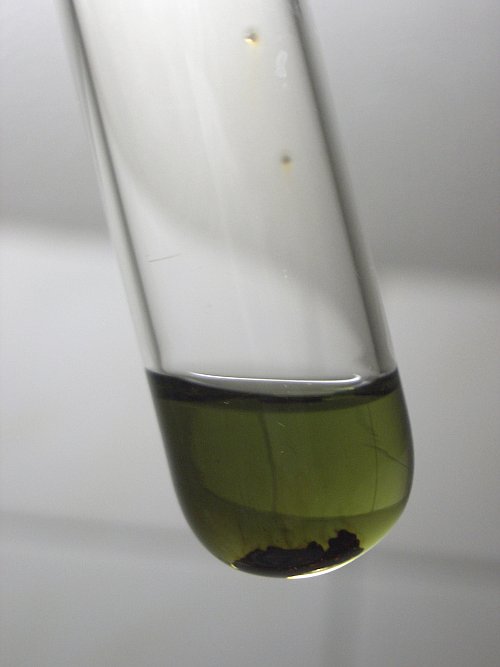
The iodine dissolves with a brown color, but the brown color quickly turns green in the oleum. The brown color is nicely demonstrated in the picture below, where some iodine is sticking on the glass wall of the test tube. The solution also becomes very dark, almost black. The color of the solution however can be observed well where it sticks to the glass walls of the test tube.
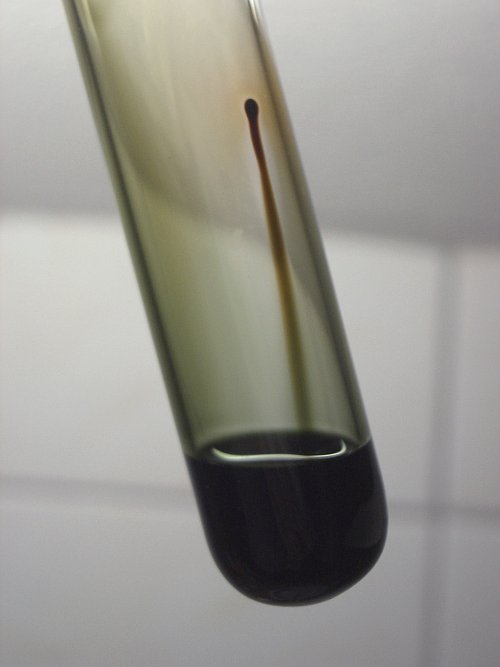
Slowly, the color of the liquid changes from olive green to blue/green. The two small pictures show how the color develops over a few minutes.
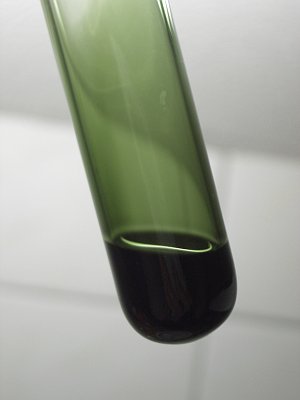
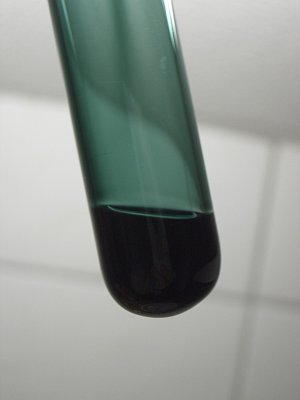
Iodine, sticking to the glass in higher parts of the test tube also liquefies and dissolves and it produces beautiful traces of blue/green viscous liquid on the glass walls of the test tube.
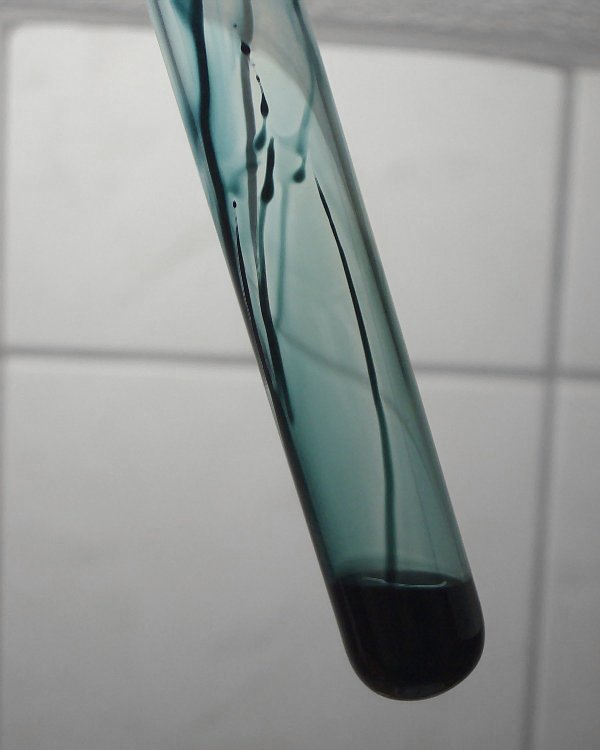
When this green/blue liquid is poured in an erlenmeyer,
filled with cold water, then the green/blue compound immediately is destroyed
and free iodine is formed, which appears as brown particles and partially
dissolves as a brown solution.
![]() This pouring of the
liquid in water must be done with really great care. The reaction between the
oleum and water is explosively violent and a scary crackling noise and a lot of
splashes are produced when the liquid comes in contact with water.
This pouring of the
liquid in water must be done with really great care. The reaction between the
oleum and water is explosively violent and a scary crackling noise and a lot of
splashes are produced when the liquid comes in contact with water.
After the oleum with the dissolved iodine is poured in water, the result is as follows:
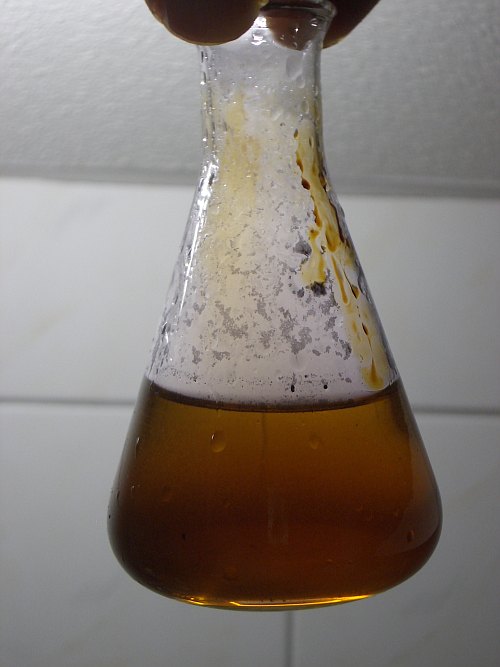
Some solid iodine sticks to the glass. A faint purple color of iodine vapor can be observed and there is the white fog, due to fuming of the oleum.
![]()
Discussion of results
It is not well-known, but iodine can form cationic species, which are extremely moisture sensitive, but in oleum these cationic species can exist. With plain oleum and no other oxidizers added, the following reaction occurs:
2I2 + 2SO3 + H2SO4 → 2I2+ + 2HSO4– + SO2
When the liquid is poured in water, then there is an immediate and very violent reaction of the SO3 with water (crackling noise and splashing) in which sulphuric acid is formed. The iodine cation immediately reacts with water, leading to formation of iodine, oxygen and acid:
4I2+ + 2H2O → 4I2 + 4H+ + O2
The liquid at once turns brown due to dissolved iodine.
Remark: More cationic halogen species exist:
- Br2+ : cherry red
- Br3+ : brown
- Br5+ : dark brown
- I3+ : very dark brown, almost black
- I42+ : red (dimer of I2+, formed at very low temperature)
- I5+ : very dark green, almost black
- I7+ (uncertain, not 100% established) : black
These other cationic species cannot be achieved with oleum alone. The information about the cationic halogen species is from Chemistry of the Elements, second edition by Greenwood and Earnshaw, pages 842 and 843.